The Yellow Mountains
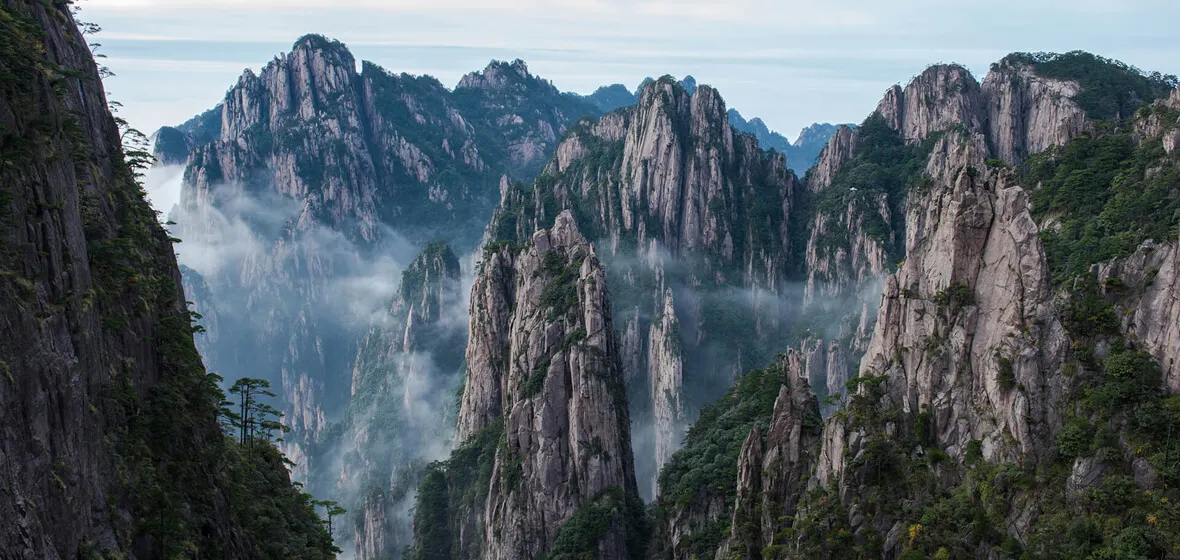
Nestled in Anhui Province in the eastern part of China, the Yellow Mountains (Mount Huang or Huangshan) are some of the most famous mountains in China, with their strangely-shaped pine trees, grotesque rocks, a sea of clouds and a hot spring proclaimed as its four wonders.
Since the Tang Dynasty (618-906CE), the Yellow Mountains have played an important part in the Chinese history of art and literature. For centuries artists have endeavored to capture the ever-changing appearance of the area. Many literati have come to visit, including Xu Xiake (1587-1641), China’s Patron Saint of Tourism, who once said “It is not worth seeing other mountains if you have been to the Five Great Mountains; and it is not worth seeing the Five Great Mountains if you have been to Yellow Mountains”. It was declared as a national park in 1982. In 1990, the mountain was listed as a UNESCO World Heritage Site. It is very popular among Chinese nationals but is somewhat underrated by the international travelers. With the bullet train, you can make it a weekend break from Hangzhou or Shanghai. Bullet trains and flights also connect it to other cities in China.
- Chinese Name: 黄山 huáng shān
- Duration: 2-3 days
-
Entrance fee:
Busy season (from 1st March to 30th November): RMB 230 n
Slack season (from 1st December to 28th February): RMB 150
The ticket is good for max 3 days. - Opening hours: 07:00-17:30
- Address: Huangshan District, Huangshan City, Anhui Province
- Best time to visit: All year round
- Bus lines: There are many public buses heading for Tangkou Town (Southern Gate Entrance /Yellow Mountain Scenic Area Transfer Station) during 6:30-17:00 every day at the Huangshan Long-distance Bus Terminal and Train Station. From there you can take a shuttle bus to the hot springs or cable car stations.
Why is it called the Yellow Mountains?
Mount Huangshan is also called the Yellow Mountains, because “Huang (黄)” in Chinese means the color of yellow, but actually the mountain is not yellow. The meaning of its name does not refer to color at all. Its original name is “Yi (黟)” Mountains, which literally means Black Mountain, because it is totally black when seen from a distance.
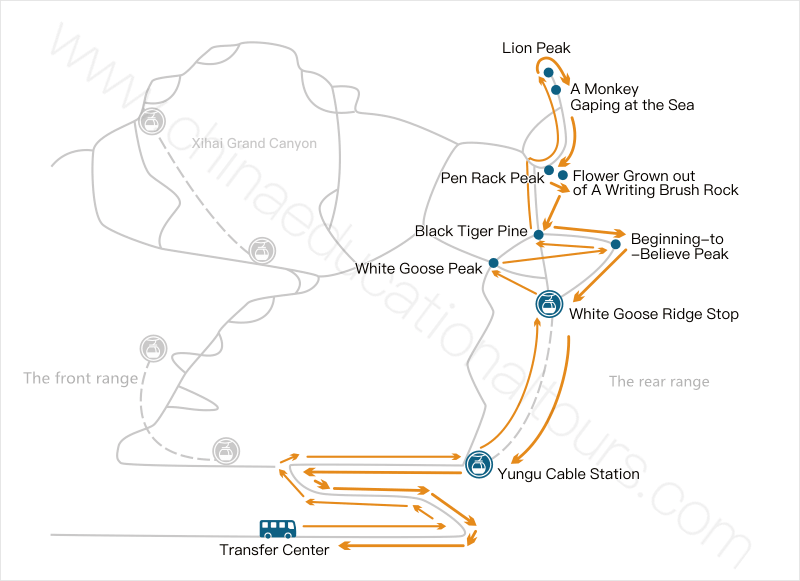
There was a legend about Huangdi or the Yellow Emperor, who is considered to be the ancestor of all Chinese. He lived on the mountain and refined his medicines that eventually allowed him to become immortal. Emperor Xuanzong of Tang believed in the legend and ordered the Yi Mountains to be renamed as Yellow Mountains to commemorate Huangdi in 747 CE.
What is the difference between Tunxi, Huangshan district and Huangshan city?
The urban center of Huangshan city was originally the city of Tunxi and is now called Tunxi District. It is where the seat of the government is located. It is also the transportation hub for the area.
Huangshan district is where the Yellow Mountains are located.
How High Are the Yellow Mountains?
The three main peaks of the Yellow Mountains are Heavenly Capital Peak, Lotus Flower Peak, and Bright Summit, which are over 1800m (5905ft). The highest, Lotus Flower Peak, is up to 1864m (6115ft).
Best Time To Visit The Yellow Mountains:
It is possible to travel to Huangshan during any of the different seasons. It depends on what you are planning to do and see there.
March to May and September to October are the best time to visit the mountains. These seasons offer comfortable weather conditions and awe-inspiring views.
But if you’re in the mood for a vacation during the colder seasons, December to April is a great time to view the sea of clouds. Additionally, you may receive off-season perks such as fewer crowds and lower prices.
Be sure to stay away from the “Golden Week” in October from 1st to 7th, as it is a national holiday in China, it will be very crowded on the mountain.
How to Plan a Trip to the Yellow Mountains
The easiest way to visit:
You can visit Huangshan Mountain within one day if your schedule is tight. Go up and go back downhill from the rear range by taking cable cars, including just a little hiking on top of the mountains.
The moderate intensity visit:
Go up and downhill from the rear range by cable car and enjoy the Xihai Grand Canyon and Baiyun Scenic Area along the way with 2 options as follows:
1) The rear range – White Goose Peak – Xihai Grand Canyon – Baiyun Scenic Area – the rear range
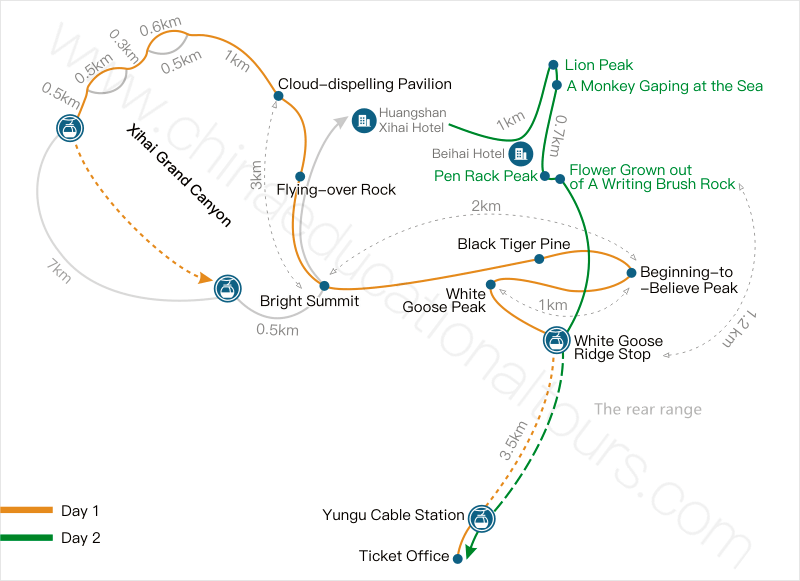
2) The rear range – Beginning-to-Believe Peak – Xihai Grand Canyon – Baiyun Scenic Area – the rear range
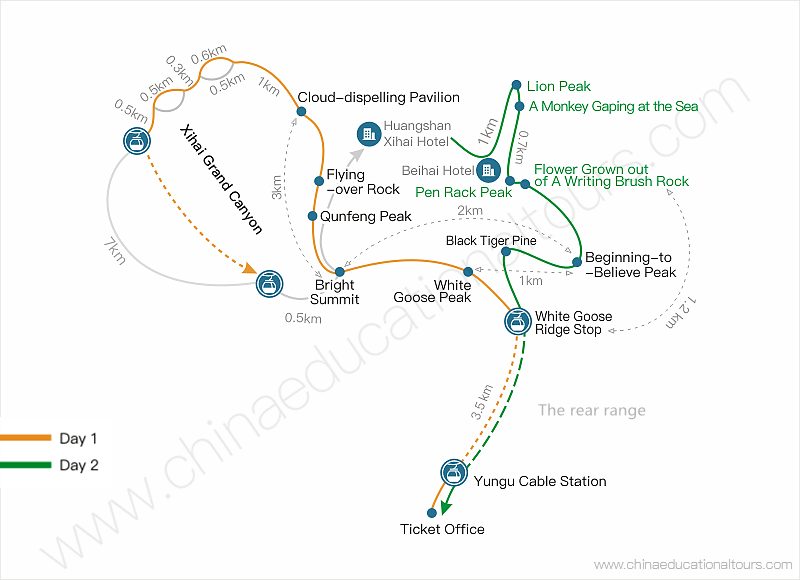
Mountaineering:
You can also go up from the front range by cable car and go downhill from the rear range by the stairs. This is the recommended route for those who are fond of hiking.
Highlights of Mt. Huangshan:
Beihai Scenic Area
Watching the ‘cloud sea’ and the sunrise are the most popular experiences at the Beihai Scenic Area. The best viewing places for watching the sunrise include Qingliang Flat, Shizi Peak, Shixin Peak (or ‘Beginning-to-Believe Peak’), Shizi Peak (or ‘Lion Peak’), and Guang Ming Ding (or ‘Bright Summit’). And the best locations for admiring the ‘cloud sea’ are Qingliang Flat, Bai’e Ling (or ‘White Goose Ridge’) and Guang Ming Ding (or ‘Bright Summit’).
Xihai Scenic Area
This scenic area is the most recently explored. Here the ‘Flying-over Stone’ appears almost magical and has become a symbol of Huangshan Mountain. You will also visit Qunfeng Peak, and the Cloud-dispelling Pavilion. The highlight of Xihai Scenic Area is Xihai Grand Canyon, it is one of the most beautiful areas on the Yellow Mountains. The hiking route for the whole canyon is 9.6 kilometers long and takes approximately 5-7 hours. It may not seem long, but it’s very challenging considering that you're descending and ascending tens of thousands of man-made steps. To save time and energy, you can take the monorail to the bottom of the canyon, then hike up. It takes you only about 2.5 hrs. The canyon is closed annually from early December to late March as it is not safe to visit it in cold weather.
Strangely-Shaped Pines
The Huangshan pine, Pinus hwangshanensis, is renowned for its peculiar shape formed by the climate and unique landform of Mount Huangshan. The pines feature thick leaves, flat crowns, and tough trunks. Many of these trees are tilted on rocks as the roots are set deep in the granite. There are 10 famous pines on top of the mountain. Among them, the most representative one is the guest-greeting pine, one of the landmarks of Mt. Huangshan. The pine grows near the Yuping Pavilion (Jade Screen Pavilion). If you meet the guest-greeting pine when climbing from the front range, it means that you have reached the top. The guest-greeting pine grows through the Stone of Crouching Lion. It is nearly 10 meters high and at least 800 years old. With its side branches gracefully extending from the stones, the pine seems like a host greeting guests with his arms stretching out.
Grotesque Rocks
Over 120 grotesque rocks with distinctive shapes have been given names on Mt. Huangshan. When seen from different locations or in different weathers, the rocks may present different appearances.
Nearly every peak on Mt. Huangshan has grotesque rocks, which were formed in the quaternary period of the glacial epoch nearly 1 million years ago. The strangely-shaped pines and grotesque rocks suggest many scenes, such as an upward writing brush in North Sea Area, an immortal giving directions, a monk gathering herbs, Suwu shepherding sheep, a flying stone, a monkey watching the sea, etc.
The Flying Rock
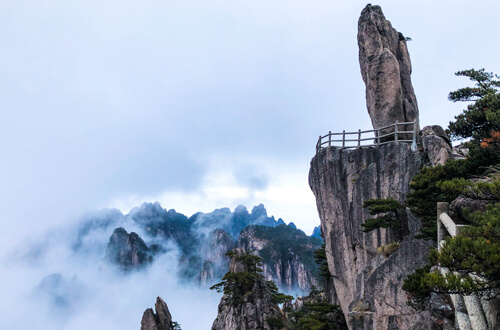
The stark Flying-Over Rock is one of the most symbolic rocks in the Yellow Mountains, tilting slightly on a flat rock platform at the top of a peak with a height of 12 meters and 2.5 meter width. It looks like a rock that has just fallen from the sky, hence its name. The coarse-grained granite mountain structure is quite weathered, after long period; this natural wonder was formed by the geologic process.
Sea of Clouds
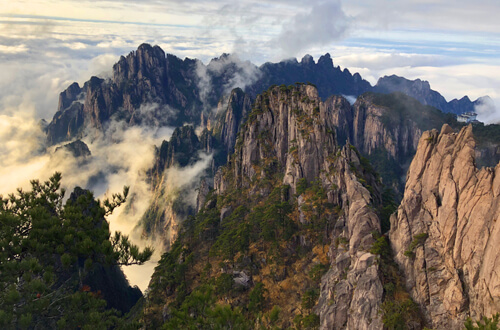
Since ancient times, Mt. Huangshan has been known as the home of clouds and mist for its sea of clouds. And the Sea of Clouds enjoys a great reputation for beautiful, magnificent, amazing and fantastic spectacles, which can be seen all year round, especially in winter. According to the distribution of the clouds, it is divided into East Sea, South Sea, West Sea, North Sea and Sky Sea. Huangshan is surrounded by clouds and mist over 200 days a year. And when moisture vapors or mist gather after raining, the Sea of Clouds will form. In Mt. Huangshan patches of red leaves floating on the Sea of Clouds is a rare spectacle seen only in the late autumn. Double Shear Peak in North Sea is another spectacle of Mt. Huangshan, with clouds pouring downward through the pressure from two sides of the Peak.
Hot Spring
The Hot Spring (called Tang Spring in ancient times) is one of “the four wonders” of Mt. Huangshan. The spring water mainly contains hydro-carbonate, suitable for drinking and bathing. The Hot Spring in Mt. Huangshan spouts from the foot of the Ziyun Peak, and is separated from the Taohua Peak by a river. It is the first stop when tourists enter Mt. Huangshan from the main entrance. The Hot Spring yields nearly 400 tons of water every day ceaselessly with its temperature maintaining nearly 42°C. There are many different types of aroma pools with varying temperatures. It can help to treat diseases involving the digestive, neural, cardiovascular, metabolic and motor systems, and also especially skin diseases. You can stay in the Huangshan Hot Springs resort, the cost of entrance to the Hot Springs is included with the hotel stay. Remember to pack a swimsuit if you plan to enjoy the hot spring.
Which Cable Car to Take
Unless you want to take almost 5500 steps to the top of the mountain, taking the cable car is the best way to go up the Yellow Mountains. Taking the cable car saves time and energy as you’ll still have to hike for hours to different attractions on the top of the mountain.
Unless you want to take almost 5500 steps to the top of the mountain, taking the cable car is the best way to go up the Yellow Mountains. Taking the cable car saves time and energy as you’ll still have to hike for hours to different attractions on the top of the mountain.
- The Yungu cable car (云谷索道) takes you from Yungu (Or Cloud Valley) station to White Goose Ridge station. You can ride this cable car if you’re starting or ending at the Southern Gate Entrance. The Southern Entrance is in Tangkou town.
- The Yuping cable car (玉屏索道) takes you from Mercy Light Pavilion to the Jade Screen Pavilion, near the Guest-greeting Pine.
- The Taiping cable car (太平索道) takes you from the Pine Valley Nunnery to Pine Forrest Peak. One-way trips last about 8-12 minutes.
Where To Stay on Top Of The Mountain
One of the top things to do in the Yellow Mountains is to watch the sunrise from the top of the mountains. If you want to see them, it’s better to spend at least one night in a hotel on top of the mountain. Accommodation options on top of the mountain are very limited and they are not of the highest standard. They also get booked up early during busy periods.
The best hotel on the mountains is Xihai Hotel (Southern Wing), but it is also the more expensive hotel on the top.
Other hotels you can choose are: Xihai Hotel (Northern Wing), Baiyun Hotel, Beihai Hotel and Paiyunlou Hotel.
Tips for visiting the Yellow Mountains
- All the available foods have been carried to the top by porters. That’s why they are expensive – one small bowl of noodles would cost you RMB 35. It is a good idea to buy some snacks beforehand.
- Do carry plenty of water as you will often need it. Water is available on the mountain, but it’s very expensive.
- If you plan to stay one night on top of the mountain, you can just bring an overnight bag to
- A rain coat or waterproof coat is needed as there are a lot of rains on the mountains.
- Good hiking shoes are necessary as you need to walk a lot of steps even if you take cable car to the top.

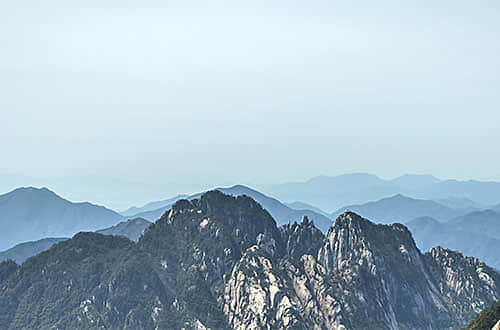 The Yellow Mountains Day Trip
The Yellow Mountains Day Trip 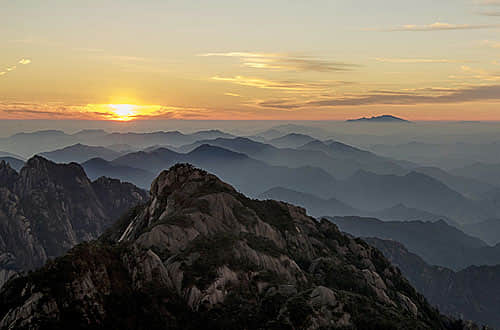 2 Days on the Yellow Mountains
2 Days on the Yellow Mountains 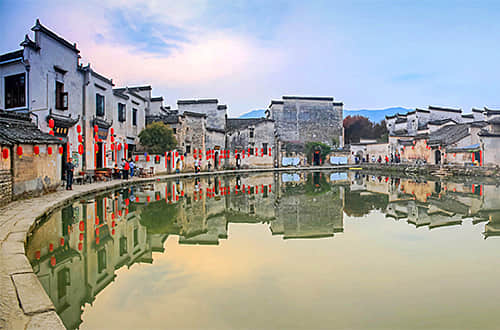 3 Days Classical Huangshan Tour
3 Days Classical Huangshan Tour 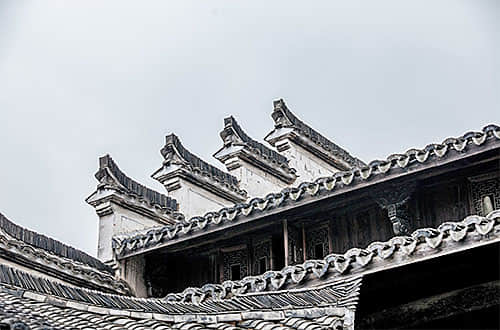 Huangshan Culture and Landscape Tour in 4 Days
Huangshan Culture and Landscape Tour in 4 Days